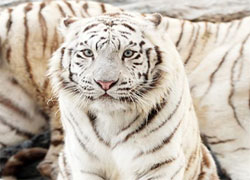
White tiger at Ever Land Amusement Park
2010 is the Year of the Tiger under the Chinese zodiac calendar. Koreans probably revere, fear and love the feline probably more than any other country.
In olden times, the tiger in Korea represented a bountiful life and hope, giving strength when people were down and preventing bad spirits from entering a home. To induce luck for a family's wellbeing, a portrait of tiger would hang on the framed doors of palaces and nobles' houses in the New Year.
With 2010 being the Year of White Tiger for the first time in 60 years, an even better fortune is believed to lie ahead for babies born this year. This will hopefully raise Korea's birth rate, which is the lowest in the world.
According to the Chinese zodiac sign, those born in the Year of the Tiger tend to be courageous, headstrong, magnanimous, charismatic, good with words, and strongly driven when performing a task. At the same time, such stubbornness and tendency to doubt can often lead to trouble. Tiger years include 1938, 1950, 1962, 1974 and 1986.
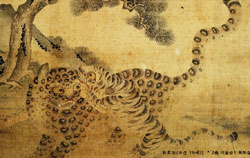
Tiger painting: National Museum of Korea
One of the oldest tiger tales in Korea is found in the origin of the country's mythical founder Dangun. A tiger failed a test to become a human but a bear that did was turned into a beautiful woman. The woman later wed the god-like Hwanung and gave birth to Dangun, who established the first nation on the Korean Peninsula in 2333 B.C. This legend gives many clues of prehistoric Korea, namely the prevalence of totemism and the major influence of the tiger in that belief system (though it may have lost the early competition with bear).
The tiger is also a fixture in traditional Korean art, appearing on mural walls of ancient kingdoms and as decorations at Buddhist and other temples and shamanist ritual sites. While neighboring Japan simply viewed the tiger as a big bad beast to get rid of, Korea held three concepts of the feline. The first was as a holy being, a guardian spirit of the nation, and a mountain god that can affect a person's fate. The second was as a fearsome beast to be avoided at all costs. And the third was as a clumsy big oaf subject to satire and humor in folktales.
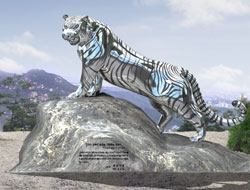
Tiger statue to be displayed at Inwangsan Mountain (Source: Jongno-gu district Office)
The view that the tiger was a mountain god was derived from its habitat deep inside a mountain. Seventy percent of the Korean landscape is mountainous, so the country is a perfect place for them to hide and dwell. This quality also gave them a more mysterious aura.
The second view focused on the harm tigers inflicted on villagers living near mountains. Tigers at times killed so many people that separate tombs were made for those killed by the animal. The tombs were also given different designs to prevent the tiger's spirit from following the dead to the next world. To the chagrin of environmentalists, the tiger became extinct in Korea in 1940 due to reckless hunting done under Japanese colonial rule (1910-45).
The third view reflects the friendly and clumsy image of the tiger as commonly depicted in Korean fairy tales. Often compared to the corrupt upper class that often disturbed commoners, they were described as being ridiculed and tricked by little rabbits and foxes. Proof of this is Korean folk arts that display tigers in colorful and funny caricatures. Thus came to be a typical way of beginning an old folktale in Korea "a long, long time ago when tigers knew how to smoke."

Hodori, the mascot of 1988 Seoul Olympic Games
Almost all tigers that appear in Korean myths, legends and folktales can talk. They occasionally get along with humans, even helping them a little. Even if the felines gobble up people for food, this usually happens after a chat or argument, showing that Koreans feel comfortable with talking tigers.
Outside Korea, the most well-known Korean tiger is Hodori, the official mascot of the 1988 Seoul Summer Olympics. The good-natured figure wore the colorful sangmo hat used in traditional Korean performing arts.
Hodori reflected friendliness and hospitality, and ranked ninth on the list of the 10 coolest Olympic mascots by Inventorsports.com in 2008 during the Beijing Olympics.
Roaring good time at tiger events
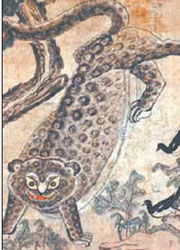
The Tiger: From Myth to Everyday Life: National Folk Museum of Korea
The Seoul district of Jongno-gu will install three gleaming tiger statues on Mount Inwang by mid-February this year. Each will be two to three meters tall. In honor of the Year of the White Tiger, major zoos nationwide including
Seoul Grand Park and
Everland in Yongin, Gyeonggi Province, will display rare white tigers.
The National Folk Museum of Korea will present
“The Tiger: From Myth to Everyday Life” an exhibit to run through March 1. Artworks will show the tiger largely as a holy being, protector from bad fortune, subject of artwork, and a concept of modern times. More than 100 artifacts will be showcased, including statues and accessories. “Jakhodo,” a painting of two magpies sitting on a pine tree speaking to a tiger, symbolizes the reciprocation of gratitude (tiger), good news (magpie), and longevity (pine tree).
The northeastern Seoul district of
Nowon-gu Office will run through Feb. 28
“Animal Kingdom – Tiger Exhibition” (Korean) on the first and second floors of its old office building. More than 3,000 artifacts related to tigers will be displayed, including stuffed tigers, the tiger animation “Hwacheopmong,” and an eight-month-old cub. For more information, call (02) 2116-3078 or the Seoul Dasan Call Center at 120 (service available in Korean, English, Chinese and Japanese).
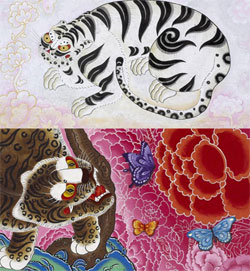
Tiger Folk Art Exhibition at Gallery I, Insa-dong
Gallery I at Seoul's Insa-dong district is running through Jan. 12
“Tiger Folk Art Exhibition” (Korean). Cartoonist Nam Jeong-ye will present colorful illustrations of tigers that also reflect the traditional humor of the Joseon Dynasty (1392-1910). For more information, call (02) 733-3695 or the Seoul Dasan Call Center at 120 (service available in Korean, English, Chinese and Japanese)
Avenuel Gallery of Lotte Department Store in Seoul's Sogong-dong district is holding through Jan. 27 a tiger exhibition by cartoonist Seo Gong-im. The event features an ancient tiger sucking on a bamboo pipe and others from the 2008 Beijing Olympics. For more information, call (02) 726-4428 or the Seoul Dasan Call Center at 120 (service available in Korean, English, Chinese and Japanese).
Seongnam Art Center will host the
“Lucky Tiger Pouch” (Korean) at its outdoor plaza until Feb. 28. It will show how the history, legends and folktales of Korea were transformed into a work of installation art.
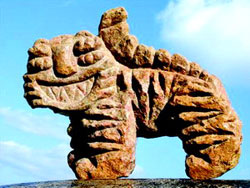
Granite tiger by Oh Chae-hyeon at Gallery the Chai
Gallery the Chai in Paju, Gyeonggi-do (Gyeonggi Province) has prepared a tiger sculpture exhibit by Oh Chae-hyeon. He will display humorous and rustic-looking tigers made of granite through Jan. 10. Call (031) 942-5429 or the Seoul Dasan Call Center at 120 (service available in Korean, English, Chinese and Japanese).
Kongkan Gallery in Busan will run “Ho-ho-ho Tiger Exhibition” until Jan. 11. Artist Ahn Yoon-mo is displaying some 20 paintings of personified tigers, including one reading a book under a pine tree and another playing a musical instrument in the moonlight. For more information, call (051) 743-6738) or the Seoul Dasan Call Center at 120 (service available in Korean, English, Chinese and Japanese).
By Kim Hee-sung
Korea.net Staff Writer